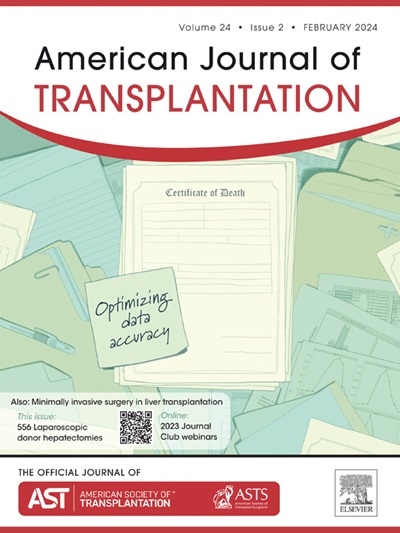45岁及以上供者活体右肝捐赠:供者和受者的结果
IF 8.2
2区 医学
Q1 SURGERY
引用次数: 0
摘要
本研究评估了老年供者(年龄≥45岁)与年轻供者(年龄<45岁)使用右叶(RL)活体肝移植(LDLT)的安全性。回顾性分析4415对供体-受体配对,包括ODs(238)和YDs(4177)。供体并发症发生率,包括总并发症(4.5% vs. 1.3%, p=0.01)和主要并发症(2.8% vs. 0.4%, p=0.02)在OD组显著降低,表明OD的手术风险没有增加。然而,与YD组相比,OD组受者胆道狭窄发生率(10.1% vs. 6.0%, p=0.01)和1年移植失败发生率(11.3% vs. 5.5%, p<0.001)显著高于OD组,移植成活率(5年:77.6% vs. 85.0%, p=0.004)显著低于OD组。此外,在MELD评分≥20的患者中,OD组受者的移植物存活率明显较差(5年:68.5%比82.2%;p=0.02)。这些结果在倾向评分匹配后保持一致。多变量Cox比例风险回归发现,使用OD移植是影响受体存活的重要危险因素。使用来自ODs的RL的LDLT增加了受者胆道狭窄和早期移植失败的风险,尤其是MELD评分≥20的受者,但不影响供者的安全性。在考虑LDLT的ODs时,仔细的供体-受体匹配至关重要。本文章由计算机程序翻译,如有差异,请以英文原文为准。
Living Right Liver Donation from Donors Aged 45 and Older: Outcomes for Both Donors and Recipients.
This study evaluated the safety of living-donor liver transplantation (LDLT) using right lobe (RL) grafts from older donors (ODs; age ≥45 years) compared to younger donors (YDs; age <45 years). A total of 4,415 donor-recipient pairs were retrospectively analyzed, including ODs (N=238) and YDs (N=4,177). Donor complication rates, including overall (4.5% vs. 1.3%, p=0.01) and major (2.8% vs. 0.4%, p=0.02) complications were significantly lower in the OD group, indicating no increased surgical risk for ODs. However, recipients of OD group showed significantly higher incidence of biliary stricture (10.1% vs. 6.0%; p=0.01) and 1-year graft failure (11.3% vs. 5.5%; p<0.001), and poorer graft survival (5-year: 77.6% vs. 85.0%; p=0.004) compared with YD group. Furthermore, among patients with MELD scores ≥20, recipients of OD group showed significantly poorer graft survival (5-year: 68.5% vs. 82.2%; p=0.02). These outcomes remained consistent after propensity score matching. Multivariable Cox proportional hazards regression identified using OD grafts as a significant risk factor for recipient graft survival. LDLT using RL from ODs increased risks of biliary stricture and early graft failure in recipients, particularly in MELD scores ≥20, without compromising donor safety. Careful donor-recipient matching is critical when considering ODs in LDLT.
求助全文
通过发布文献求助,成功后即可免费获取论文全文。
去求助
来源期刊
CiteScore
18.70
自引率
4.50%
发文量
346
审稿时长
26 days
期刊介绍:
The American Journal of Transplantation is a leading journal in the field of transplantation. It serves as a forum for debate and reassessment, an agent of change, and a major platform for promoting understanding, improving results, and advancing science. Published monthly, it provides an essential resource for researchers and clinicians worldwide.
The journal publishes original articles, case reports, invited reviews, letters to the editor, critical reviews, news features, consensus documents, and guidelines over 12 issues a year. It covers all major subject areas in transplantation, including thoracic (heart, lung), abdominal (kidney, liver, pancreas, islets), tissue and stem cell transplantation, organ and tissue donation and preservation, tissue injury, repair, inflammation, and aging, histocompatibility, drugs and pharmacology, graft survival, and prevention of graft dysfunction and failure. It also explores ethical and social issues in the field.

 求助内容:
求助内容: 应助结果提醒方式:
应助结果提醒方式:


